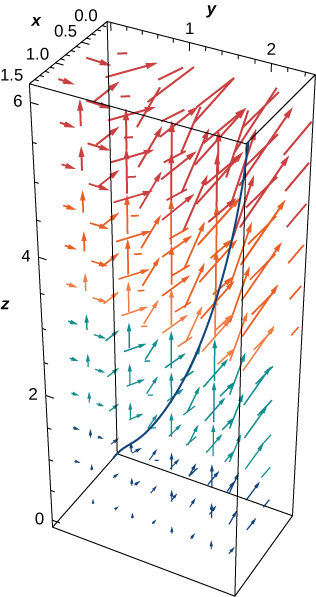| << Chapter < Page | Chapter >> Page > |
Calculate the mass of a spring in the shape of a helix parameterized by with a density function given by kg/m.
kg
When we first defined vector line integrals, we used the concept of work to motivate the definition. Therefore, it is not surprising that calculating the work done by a vector field representing a force is a standard use of vector line integrals. Recall that if an object moves along curve C in force field F , then the work required to move the object is given by
How much work is required to move an object in vector force field along path See [link] .
Let C denote the given path. We need to find the value of To do this, we use [link] :

We close this section by discussing two key concepts related to line integrals: flux across a plane curve and circulation along a plane curve. Flux is used in applications to calculate fluid flow across a curve, and the concept of circulation is important for characterizing conservative gradient fields in terms of line integrals. Both these concepts are used heavily throughout the rest of this chapter. The idea of flux is especially important for Green’s theorem, and in higher dimensions for Stokes’ theorem and the divergence theorem.
Let C be a plane curve and let F be a vector field in the plane. Imagine C is a membrane across which fluid flows, but C does not impede the flow of the fluid. In other words, C is an idealized membrane invisible to the fluid. Suppose F represents the velocity field of the fluid. How could we quantify the rate at which the fluid is crossing C ?
Recall that the line integral of F along C is —in other words, the line integral is the dot product of the vector field with the unit tangential vector with respect to arc length. If we replace the unit tangential vector with unit normal vector and instead compute integral we determine the flux across C . To be precise, the definition of integral is the same as integral except the T in the Riemann sum is replaced with N . Therefore, the flux across C is defined as
where and are defined as they were for integral Therefore, a flux integral is an integral that is perpendicular to a vector line integral, because N and T are perpendicular vectors.
If F is a velocity field of a fluid and C is a curve that represents a membrane, then the flux of F across C is the quantity of fluid flowing across C per unit time, or the rate of flow.
More formally, let C be a plane curve parameterized by Let be the vector that is normal to C at the endpoint of and points to the right as we traverse C in the positive direction ( [link] ). Then, is the unit normal vector to C at the endpoint of that points to the right as we traverse C .
The flux of F across C is line integral

Notification Switch
Would you like to follow the 'Calculus volume 3' conversation and receive update notifications?